Gestalt Therapy: A Comprehensive Analysis of Its Core Concepts
VerifiedAdded on 2020/10/22
|7
|2479
|223
Essay
AI Summary
This essay provides a comprehensive overview of Gestalt therapy, a humanistic approach founded by Fritz Perls, Laura Perls, and Paul Goodman, emphasizing awareness, the here-and-now experience, and the individual's relationship with their environment. It delves into the philosophical foundations, including field theory, phenomenology, and dialogue, and explores key concepts like the gestalt cycle of experience, contact boundary disturbances (desensitization, deflection, introjection, projection, retroflection, egotism, and confluence), and the figure-ground relationship. The essay highlights the importance of existential phenomenology and the role of therapeutic strategies, including physical and body awareness and experimentation. The essay examines the therapist's role in fostering a meaningful and relational connection with the client, and emphasizes the holistic nature of Gestalt therapy, which considers all dimensions of a person's experience. The essay emphasizes the importance of increasing awareness of an individual's experience, the nature and language which is used by the client and also about the contact formation which is with the environment and also the role of the therapist.
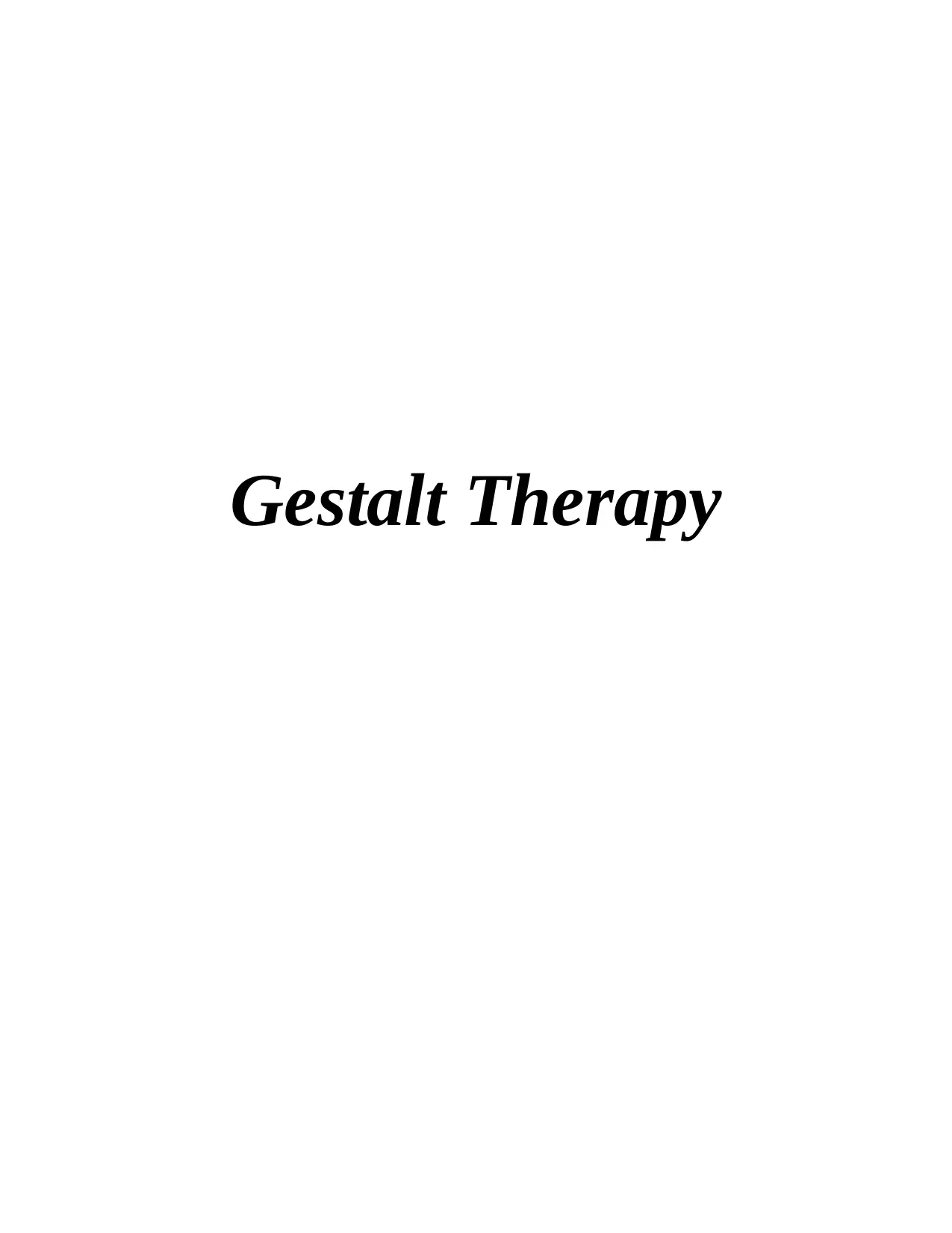
Gestalt Therapy
Paraphrase This Document
Need a fresh take? Get an instant paraphrase of this document with our AI Paraphraser
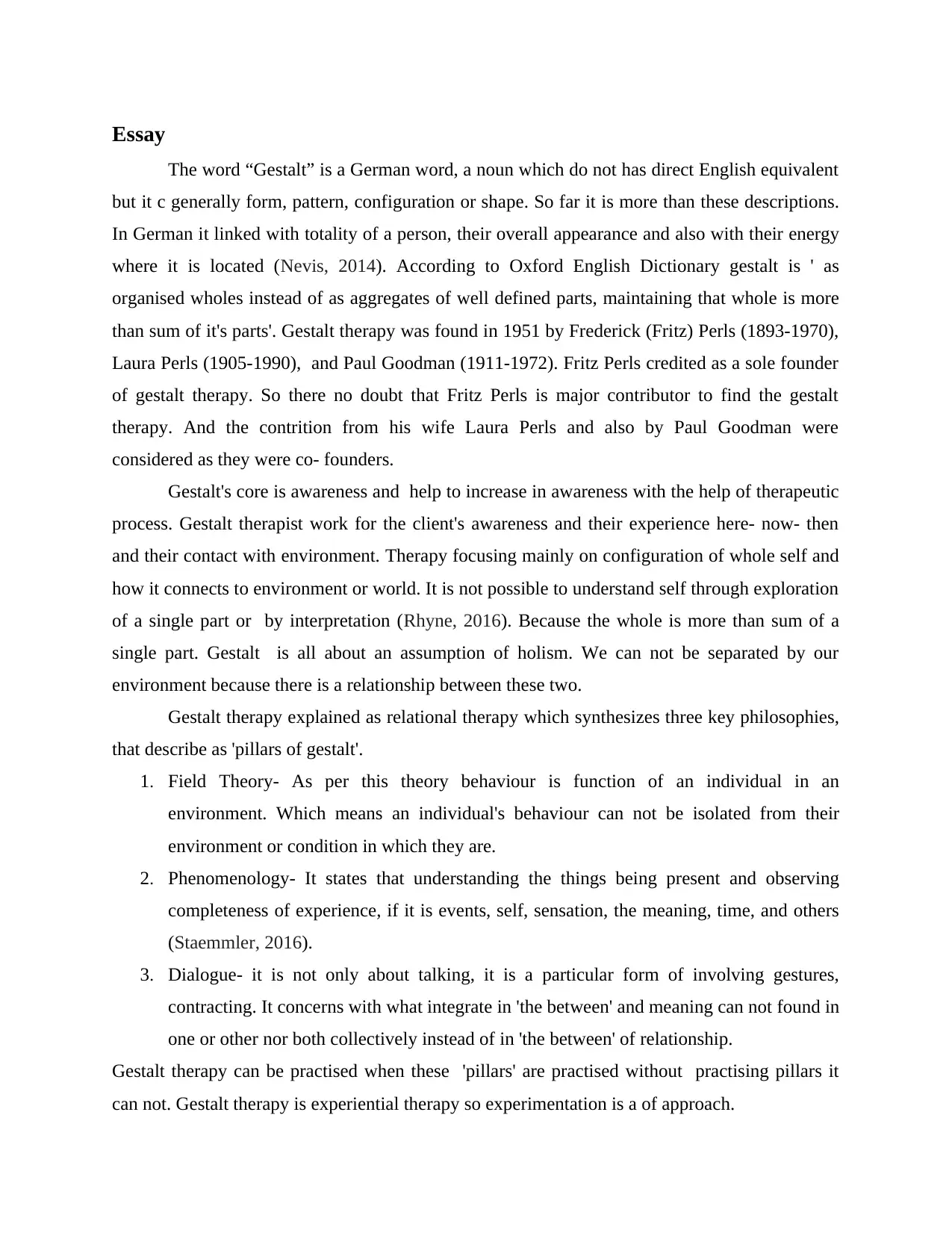
Essay
The word “Gestalt” is a German word, a noun which do not has direct English equivalent
but it c generally form, pattern, configuration or shape. So far it is more than these descriptions.
In German it linked with totality of a person, their overall appearance and also with their energy
where it is located (Nevis, 2014). According to Oxford English Dictionary gestalt is ' as
organised wholes instead of as aggregates of well defined parts, maintaining that whole is more
than sum of it's parts'. Gestalt therapy was found in 1951 by Frederick (Fritz) Perls (1893-1970),
Laura Perls (1905-1990), and Paul Goodman (1911-1972). Fritz Perls credited as a sole founder
of gestalt therapy. So there no doubt that Fritz Perls is major contributor to find the gestalt
therapy. And the contrition from his wife Laura Perls and also by Paul Goodman were
considered as they were co- founders.
Gestalt's core is awareness and help to increase in awareness with the help of therapeutic
process. Gestalt therapist work for the client's awareness and their experience here- now- then
and their contact with environment. Therapy focusing mainly on configuration of whole self and
how it connects to environment or world. It is not possible to understand self through exploration
of a single part or by interpretation (Rhyne, 2016). Because the whole is more than sum of a
single part. Gestalt is all about an assumption of holism. We can not be separated by our
environment because there is a relationship between these two.
Gestalt therapy explained as relational therapy which synthesizes three key philosophies,
that describe as 'pillars of gestalt'.
1. Field Theory- As per this theory behaviour is function of an individual in an
environment. Which means an individual's behaviour can not be isolated from their
environment or condition in which they are.
2. Phenomenology- It states that understanding the things being present and observing
completeness of experience, if it is events, self, sensation, the meaning, time, and others
(Staemmler, 2016).
3. Dialogue- it is not only about talking, it is a particular form of involving gestures,
contracting. It concerns with what integrate in 'the between' and meaning can not found in
one or other nor both collectively instead of in 'the between' of relationship.
Gestalt therapy can be practised when these 'pillars' are practised without practising pillars it
can not. Gestalt therapy is experiential therapy so experimentation is a of approach.
The word “Gestalt” is a German word, a noun which do not has direct English equivalent
but it c generally form, pattern, configuration or shape. So far it is more than these descriptions.
In German it linked with totality of a person, their overall appearance and also with their energy
where it is located (Nevis, 2014). According to Oxford English Dictionary gestalt is ' as
organised wholes instead of as aggregates of well defined parts, maintaining that whole is more
than sum of it's parts'. Gestalt therapy was found in 1951 by Frederick (Fritz) Perls (1893-1970),
Laura Perls (1905-1990), and Paul Goodman (1911-1972). Fritz Perls credited as a sole founder
of gestalt therapy. So there no doubt that Fritz Perls is major contributor to find the gestalt
therapy. And the contrition from his wife Laura Perls and also by Paul Goodman were
considered as they were co- founders.
Gestalt's core is awareness and help to increase in awareness with the help of therapeutic
process. Gestalt therapist work for the client's awareness and their experience here- now- then
and their contact with environment. Therapy focusing mainly on configuration of whole self and
how it connects to environment or world. It is not possible to understand self through exploration
of a single part or by interpretation (Rhyne, 2016). Because the whole is more than sum of a
single part. Gestalt is all about an assumption of holism. We can not be separated by our
environment because there is a relationship between these two.
Gestalt therapy explained as relational therapy which synthesizes three key philosophies,
that describe as 'pillars of gestalt'.
1. Field Theory- As per this theory behaviour is function of an individual in an
environment. Which means an individual's behaviour can not be isolated from their
environment or condition in which they are.
2. Phenomenology- It states that understanding the things being present and observing
completeness of experience, if it is events, self, sensation, the meaning, time, and others
(Staemmler, 2016).
3. Dialogue- it is not only about talking, it is a particular form of involving gestures,
contracting. It concerns with what integrate in 'the between' and meaning can not found in
one or other nor both collectively instead of in 'the between' of relationship.
Gestalt therapy can be practised when these 'pillars' are practised without practising pillars it
can not. Gestalt therapy is experiential therapy so experimentation is a of approach.
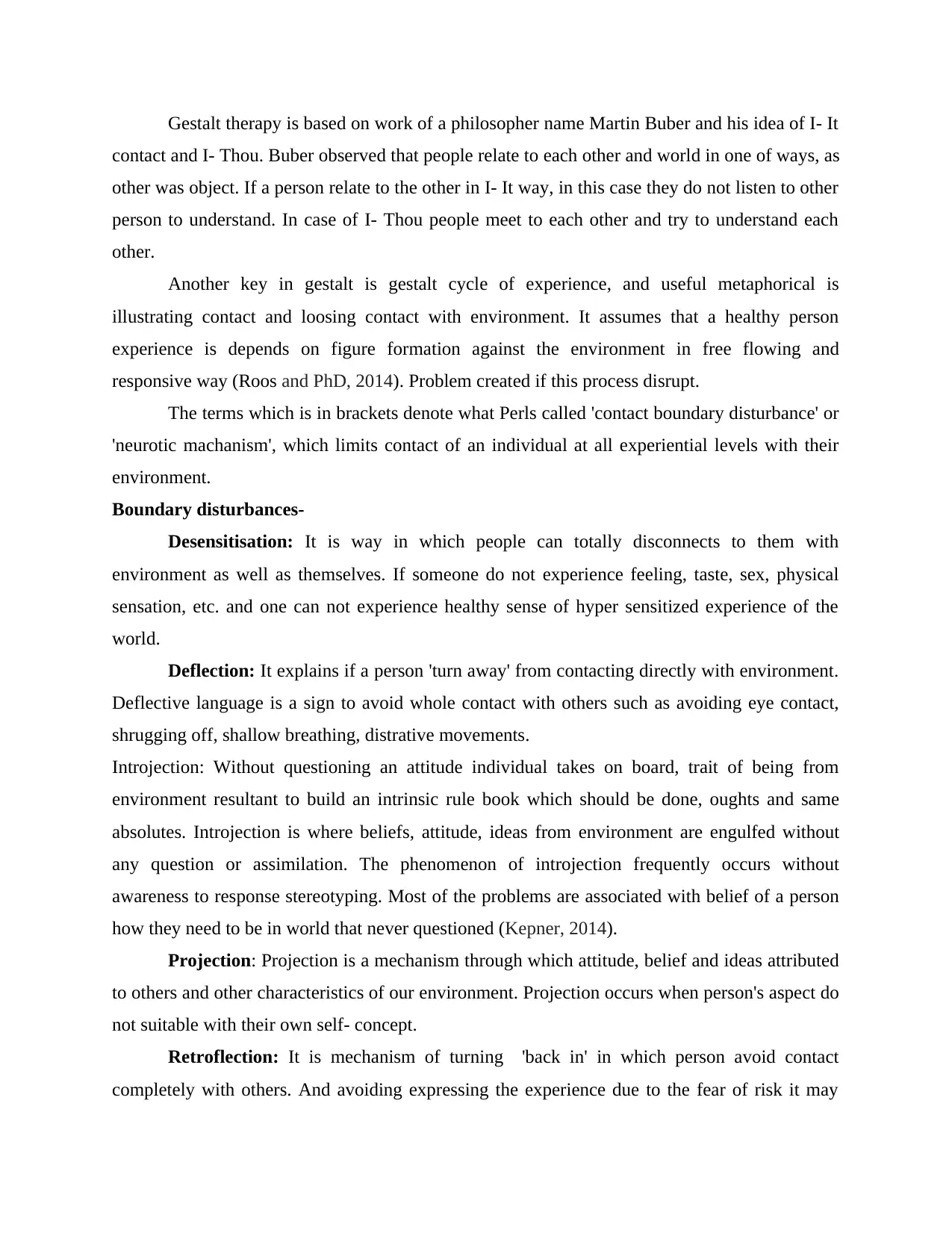
Gestalt therapy is based on work of a philosopher name Martin Buber and his idea of I- It
contact and I- Thou. Buber observed that people relate to each other and world in one of ways, as
other was object. If a person relate to the other in I- It way, in this case they do not listen to other
person to understand. In case of I- Thou people meet to each other and try to understand each
other.
Another key in gestalt is gestalt cycle of experience, and useful metaphorical is
illustrating contact and loosing contact with environment. It assumes that a healthy person
experience is depends on figure formation against the environment in free flowing and
responsive way (Roos and PhD, 2014). Problem created if this process disrupt.
The terms which is in brackets denote what Perls called 'contact boundary disturbance' or
'neurotic machanism', which limits contact of an individual at all experiential levels with their
environment.
Boundary disturbances-
Desensitisation: It is way in which people can totally disconnects to them with
environment as well as themselves. If someone do not experience feeling, taste, sex, physical
sensation, etc. and one can not experience healthy sense of hyper sensitized experience of the
world.
Deflection: It explains if a person 'turn away' from contacting directly with environment.
Deflective language is a sign to avoid whole contact with others such as avoiding eye contact,
shrugging off, shallow breathing, distrative movements.
Introjection: Without questioning an attitude individual takes on board, trait of being from
environment resultant to build an intrinsic rule book which should be done, oughts and same
absolutes. Introjection is where beliefs, attitude, ideas from environment are engulfed without
any question or assimilation. The phenomenon of introjection frequently occurs without
awareness to response stereotyping. Most of the problems are associated with belief of a person
how they need to be in world that never questioned (Kepner, 2014).
Projection: Projection is a mechanism through which attitude, belief and ideas attributed
to others and other characteristics of our environment. Projection occurs when person's aspect do
not suitable with their own self- concept.
Retroflection: It is mechanism of turning 'back in' in which person avoid contact
completely with others. And avoiding expressing the experience due to the fear of risk it may
contact and I- Thou. Buber observed that people relate to each other and world in one of ways, as
other was object. If a person relate to the other in I- It way, in this case they do not listen to other
person to understand. In case of I- Thou people meet to each other and try to understand each
other.
Another key in gestalt is gestalt cycle of experience, and useful metaphorical is
illustrating contact and loosing contact with environment. It assumes that a healthy person
experience is depends on figure formation against the environment in free flowing and
responsive way (Roos and PhD, 2014). Problem created if this process disrupt.
The terms which is in brackets denote what Perls called 'contact boundary disturbance' or
'neurotic machanism', which limits contact of an individual at all experiential levels with their
environment.
Boundary disturbances-
Desensitisation: It is way in which people can totally disconnects to them with
environment as well as themselves. If someone do not experience feeling, taste, sex, physical
sensation, etc. and one can not experience healthy sense of hyper sensitized experience of the
world.
Deflection: It explains if a person 'turn away' from contacting directly with environment.
Deflective language is a sign to avoid whole contact with others such as avoiding eye contact,
shrugging off, shallow breathing, distrative movements.
Introjection: Without questioning an attitude individual takes on board, trait of being from
environment resultant to build an intrinsic rule book which should be done, oughts and same
absolutes. Introjection is where beliefs, attitude, ideas from environment are engulfed without
any question or assimilation. The phenomenon of introjection frequently occurs without
awareness to response stereotyping. Most of the problems are associated with belief of a person
how they need to be in world that never questioned (Kepner, 2014).
Projection: Projection is a mechanism through which attitude, belief and ideas attributed
to others and other characteristics of our environment. Projection occurs when person's aspect do
not suitable with their own self- concept.
Retroflection: It is mechanism of turning 'back in' in which person avoid contact
completely with others. And avoiding expressing the experience due to the fear of risk it may
⊘ This is a preview!⊘
Do you want full access?
Subscribe today to unlock all pages.

Trusted by 1+ million students worldwide
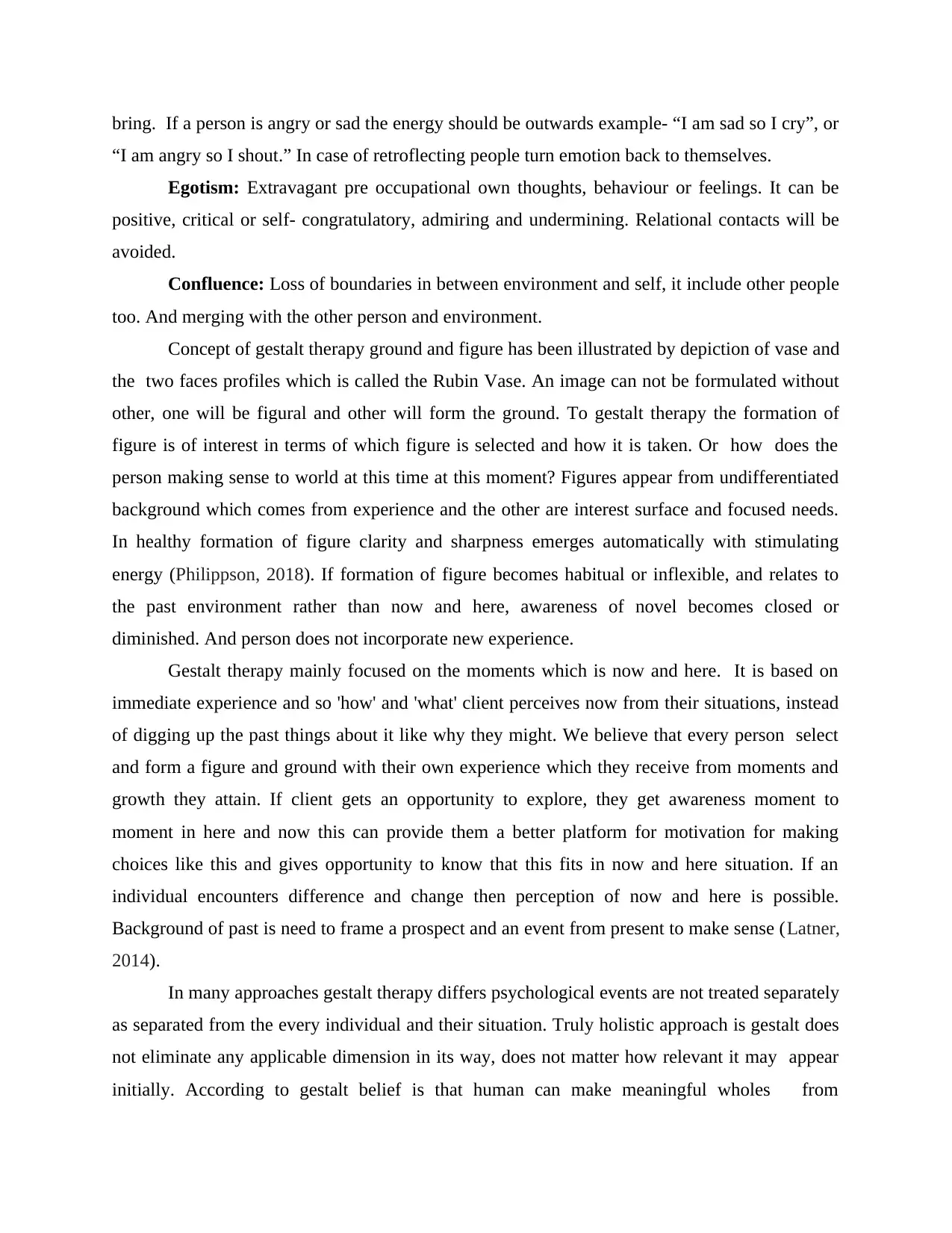
bring. If a person is angry or sad the energy should be outwards example- “I am sad so I cry”, or
“I am angry so I shout.” In case of retroflecting people turn emotion back to themselves.
Egotism: Extravagant pre occupational own thoughts, behaviour or feelings. It can be
positive, critical or self- congratulatory, admiring and undermining. Relational contacts will be
avoided.
Confluence: Loss of boundaries in between environment and self, it include other people
too. And merging with the other person and environment.
Concept of gestalt therapy ground and figure has been illustrated by depiction of vase and
the two faces profiles which is called the Rubin Vase. An image can not be formulated without
other, one will be figural and other will form the ground. To gestalt therapy the formation of
figure is of interest in terms of which figure is selected and how it is taken. Or how does the
person making sense to world at this time at this moment? Figures appear from undifferentiated
background which comes from experience and the other are interest surface and focused needs.
In healthy formation of figure clarity and sharpness emerges automatically with stimulating
energy (Philippson, 2018). If formation of figure becomes habitual or inflexible, and relates to
the past environment rather than now and here, awareness of novel becomes closed or
diminished. And person does not incorporate new experience.
Gestalt therapy mainly focused on the moments which is now and here. It is based on
immediate experience and so 'how' and 'what' client perceives now from their situations, instead
of digging up the past things about it like why they might. We believe that every person select
and form a figure and ground with their own experience which they receive from moments and
growth they attain. If client gets an opportunity to explore, they get awareness moment to
moment in here and now this can provide them a better platform for motivation for making
choices like this and gives opportunity to know that this fits in now and here situation. If an
individual encounters difference and change then perception of now and here is possible.
Background of past is need to frame a prospect and an event from present to make sense (Latner,
2014).
In many approaches gestalt therapy differs psychological events are not treated separately
as separated from the every individual and their situation. Truly holistic approach is gestalt does
not eliminate any applicable dimension in its way, does not matter how relevant it may appear
initially. According to gestalt belief is that human can make meaningful wholes from
“I am angry so I shout.” In case of retroflecting people turn emotion back to themselves.
Egotism: Extravagant pre occupational own thoughts, behaviour or feelings. It can be
positive, critical or self- congratulatory, admiring and undermining. Relational contacts will be
avoided.
Confluence: Loss of boundaries in between environment and self, it include other people
too. And merging with the other person and environment.
Concept of gestalt therapy ground and figure has been illustrated by depiction of vase and
the two faces profiles which is called the Rubin Vase. An image can not be formulated without
other, one will be figural and other will form the ground. To gestalt therapy the formation of
figure is of interest in terms of which figure is selected and how it is taken. Or how does the
person making sense to world at this time at this moment? Figures appear from undifferentiated
background which comes from experience and the other are interest surface and focused needs.
In healthy formation of figure clarity and sharpness emerges automatically with stimulating
energy (Philippson, 2018). If formation of figure becomes habitual or inflexible, and relates to
the past environment rather than now and here, awareness of novel becomes closed or
diminished. And person does not incorporate new experience.
Gestalt therapy mainly focused on the moments which is now and here. It is based on
immediate experience and so 'how' and 'what' client perceives now from their situations, instead
of digging up the past things about it like why they might. We believe that every person select
and form a figure and ground with their own experience which they receive from moments and
growth they attain. If client gets an opportunity to explore, they get awareness moment to
moment in here and now this can provide them a better platform for motivation for making
choices like this and gives opportunity to know that this fits in now and here situation. If an
individual encounters difference and change then perception of now and here is possible.
Background of past is need to frame a prospect and an event from present to make sense (Latner,
2014).
In many approaches gestalt therapy differs psychological events are not treated separately
as separated from the every individual and their situation. Truly holistic approach is gestalt does
not eliminate any applicable dimension in its way, does not matter how relevant it may appear
initially. According to gestalt belief is that human can make meaningful wholes from
Paraphrase This Document
Need a fresh take? Get an instant paraphrase of this document with our AI Paraphraser
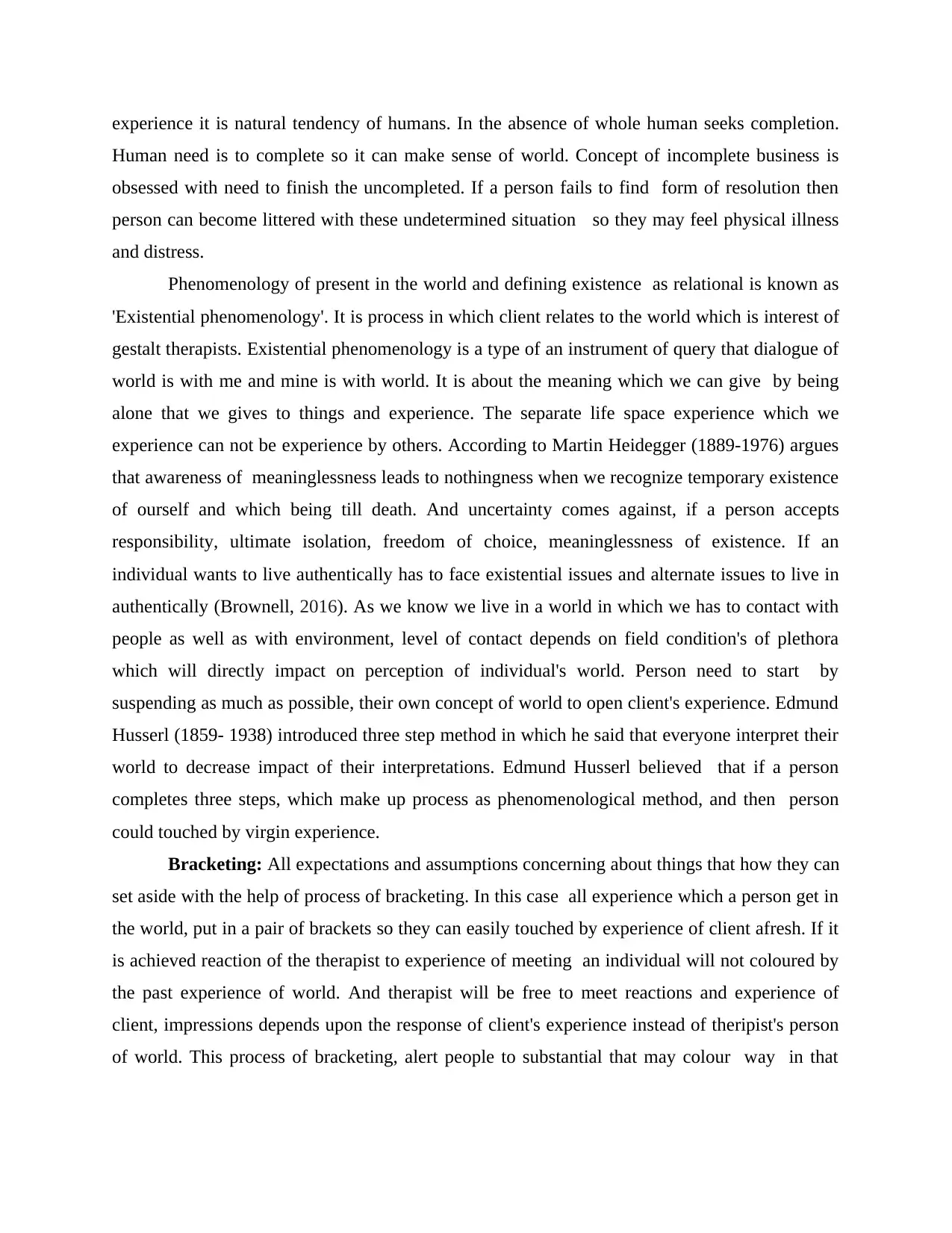
experience it is natural tendency of humans. In the absence of whole human seeks completion.
Human need is to complete so it can make sense of world. Concept of incomplete business is
obsessed with need to finish the uncompleted. If a person fails to find form of resolution then
person can become littered with these undetermined situation so they may feel physical illness
and distress.
Phenomenology of present in the world and defining existence as relational is known as
'Existential phenomenology'. It is process in which client relates to the world which is interest of
gestalt therapists. Existential phenomenology is a type of an instrument of query that dialogue of
world is with me and mine is with world. It is about the meaning which we can give by being
alone that we gives to things and experience. The separate life space experience which we
experience can not be experience by others. According to Martin Heidegger (1889-1976) argues
that awareness of meaninglessness leads to nothingness when we recognize temporary existence
of ourself and which being till death. And uncertainty comes against, if a person accepts
responsibility, ultimate isolation, freedom of choice, meaninglessness of existence. If an
individual wants to live authentically has to face existential issues and alternate issues to live in
authentically (Brownell, 2016). As we know we live in a world in which we has to contact with
people as well as with environment, level of contact depends on field condition's of plethora
which will directly impact on perception of individual's world. Person need to start by
suspending as much as possible, their own concept of world to open client's experience. Edmund
Husserl (1859- 1938) introduced three step method in which he said that everyone interpret their
world to decrease impact of their interpretations. Edmund Husserl believed that if a person
completes three steps, which make up process as phenomenological method, and then person
could touched by virgin experience.
Bracketing: All expectations and assumptions concerning about things that how they can
set aside with the help of process of bracketing. In this case all experience which a person get in
the world, put in a pair of brackets so they can easily touched by experience of client afresh. If it
is achieved reaction of the therapist to experience of meeting an individual will not coloured by
the past experience of world. And therapist will be free to meet reactions and experience of
client, impressions depends upon the response of client's experience instead of theripist's person
of world. This process of bracketing, alert people to substantial that may colour way in that
Human need is to complete so it can make sense of world. Concept of incomplete business is
obsessed with need to finish the uncompleted. If a person fails to find form of resolution then
person can become littered with these undetermined situation so they may feel physical illness
and distress.
Phenomenology of present in the world and defining existence as relational is known as
'Existential phenomenology'. It is process in which client relates to the world which is interest of
gestalt therapists. Existential phenomenology is a type of an instrument of query that dialogue of
world is with me and mine is with world. It is about the meaning which we can give by being
alone that we gives to things and experience. The separate life space experience which we
experience can not be experience by others. According to Martin Heidegger (1889-1976) argues
that awareness of meaninglessness leads to nothingness when we recognize temporary existence
of ourself and which being till death. And uncertainty comes against, if a person accepts
responsibility, ultimate isolation, freedom of choice, meaninglessness of existence. If an
individual wants to live authentically has to face existential issues and alternate issues to live in
authentically (Brownell, 2016). As we know we live in a world in which we has to contact with
people as well as with environment, level of contact depends on field condition's of plethora
which will directly impact on perception of individual's world. Person need to start by
suspending as much as possible, their own concept of world to open client's experience. Edmund
Husserl (1859- 1938) introduced three step method in which he said that everyone interpret their
world to decrease impact of their interpretations. Edmund Husserl believed that if a person
completes three steps, which make up process as phenomenological method, and then person
could touched by virgin experience.
Bracketing: All expectations and assumptions concerning about things that how they can
set aside with the help of process of bracketing. In this case all experience which a person get in
the world, put in a pair of brackets so they can easily touched by experience of client afresh. If it
is achieved reaction of the therapist to experience of meeting an individual will not coloured by
the past experience of world. And therapist will be free to meet reactions and experience of
client, impressions depends upon the response of client's experience instead of theripist's person
of world. This process of bracketing, alert people to substantial that may colour way in that
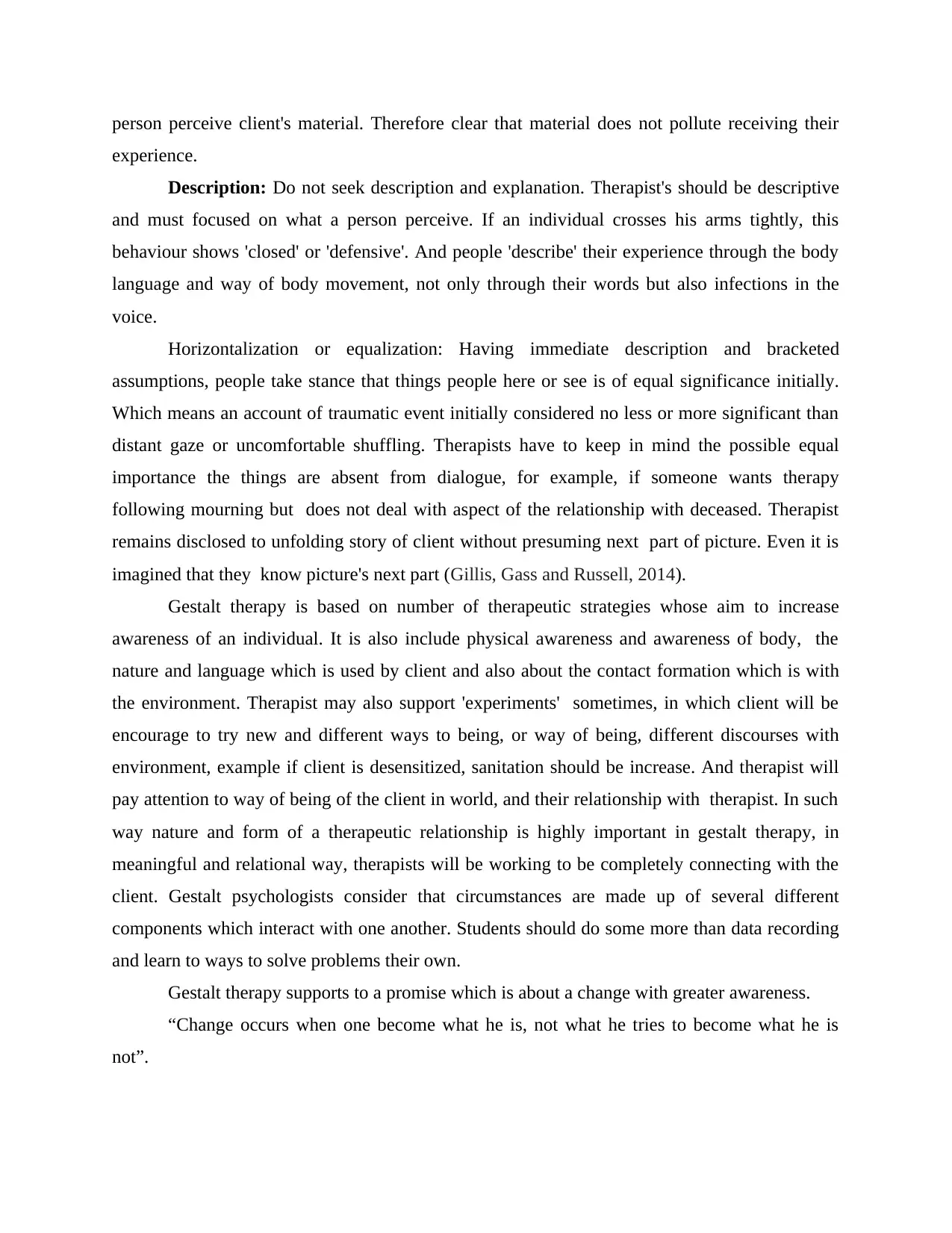
person perceive client's material. Therefore clear that material does not pollute receiving their
experience.
Description: Do not seek description and explanation. Therapist's should be descriptive
and must focused on what a person perceive. If an individual crosses his arms tightly, this
behaviour shows 'closed' or 'defensive'. And people 'describe' their experience through the body
language and way of body movement, not only through their words but also infections in the
voice.
Horizontalization or equalization: Having immediate description and bracketed
assumptions, people take stance that things people here or see is of equal significance initially.
Which means an account of traumatic event initially considered no less or more significant than
distant gaze or uncomfortable shuffling. Therapists have to keep in mind the possible equal
importance the things are absent from dialogue, for example, if someone wants therapy
following mourning but does not deal with aspect of the relationship with deceased. Therapist
remains disclosed to unfolding story of client without presuming next part of picture. Even it is
imagined that they know picture's next part (Gillis, Gass and Russell, 2014).
Gestalt therapy is based on number of therapeutic strategies whose aim to increase
awareness of an individual. It is also include physical awareness and awareness of body, the
nature and language which is used by client and also about the contact formation which is with
the environment. Therapist may also support 'experiments' sometimes, in which client will be
encourage to try new and different ways to being, or way of being, different discourses with
environment, example if client is desensitized, sanitation should be increase. And therapist will
pay attention to way of being of the client in world, and their relationship with therapist. In such
way nature and form of a therapeutic relationship is highly important in gestalt therapy, in
meaningful and relational way, therapists will be working to be completely connecting with the
client. Gestalt psychologists consider that circumstances are made up of several different
components which interact with one another. Students should do some more than data recording
and learn to ways to solve problems their own.
Gestalt therapy supports to a promise which is about a change with greater awareness.
“Change occurs when one become what he is, not what he tries to become what he is
not”.
experience.
Description: Do not seek description and explanation. Therapist's should be descriptive
and must focused on what a person perceive. If an individual crosses his arms tightly, this
behaviour shows 'closed' or 'defensive'. And people 'describe' their experience through the body
language and way of body movement, not only through their words but also infections in the
voice.
Horizontalization or equalization: Having immediate description and bracketed
assumptions, people take stance that things people here or see is of equal significance initially.
Which means an account of traumatic event initially considered no less or more significant than
distant gaze or uncomfortable shuffling. Therapists have to keep in mind the possible equal
importance the things are absent from dialogue, for example, if someone wants therapy
following mourning but does not deal with aspect of the relationship with deceased. Therapist
remains disclosed to unfolding story of client without presuming next part of picture. Even it is
imagined that they know picture's next part (Gillis, Gass and Russell, 2014).
Gestalt therapy is based on number of therapeutic strategies whose aim to increase
awareness of an individual. It is also include physical awareness and awareness of body, the
nature and language which is used by client and also about the contact formation which is with
the environment. Therapist may also support 'experiments' sometimes, in which client will be
encourage to try new and different ways to being, or way of being, different discourses with
environment, example if client is desensitized, sanitation should be increase. And therapist will
pay attention to way of being of the client in world, and their relationship with therapist. In such
way nature and form of a therapeutic relationship is highly important in gestalt therapy, in
meaningful and relational way, therapists will be working to be completely connecting with the
client. Gestalt psychologists consider that circumstances are made up of several different
components which interact with one another. Students should do some more than data recording
and learn to ways to solve problems their own.
Gestalt therapy supports to a promise which is about a change with greater awareness.
“Change occurs when one become what he is, not what he tries to become what he is
not”.
⊘ This is a preview!⊘
Do you want full access?
Subscribe today to unlock all pages.

Trusted by 1+ million students worldwide
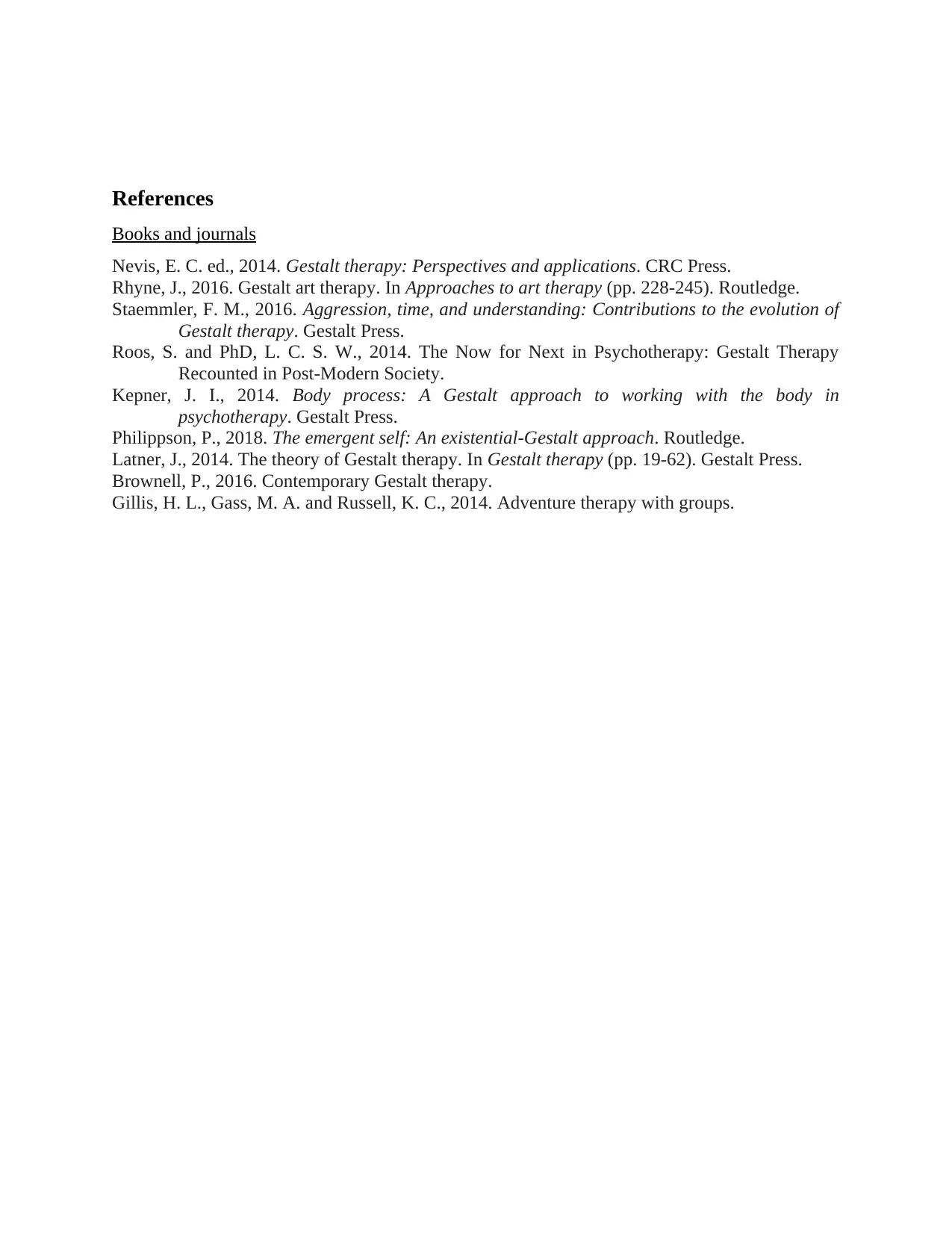
References
Books and journals
Nevis, E. C. ed., 2014. Gestalt therapy: Perspectives and applications. CRC Press.
Rhyne, J., 2016. Gestalt art therapy. In Approaches to art therapy (pp. 228-245). Routledge.
Staemmler, F. M., 2016. Aggression, time, and understanding: Contributions to the evolution of
Gestalt therapy. Gestalt Press.
Roos, S. and PhD, L. C. S. W., 2014. The Now for Next in Psychotherapy: Gestalt Therapy
Recounted in Post-Modern Society.
Kepner, J. I., 2014. Body process: A Gestalt approach to working with the body in
psychotherapy. Gestalt Press.
Philippson, P., 2018. The emergent self: An existential-Gestalt approach. Routledge.
Latner, J., 2014. The theory of Gestalt therapy. In Gestalt therapy (pp. 19-62). Gestalt Press.
Brownell, P., 2016. Contemporary Gestalt therapy.
Gillis, H. L., Gass, M. A. and Russell, K. C., 2014. Adventure therapy with groups.
Books and journals
Nevis, E. C. ed., 2014. Gestalt therapy: Perspectives and applications. CRC Press.
Rhyne, J., 2016. Gestalt art therapy. In Approaches to art therapy (pp. 228-245). Routledge.
Staemmler, F. M., 2016. Aggression, time, and understanding: Contributions to the evolution of
Gestalt therapy. Gestalt Press.
Roos, S. and PhD, L. C. S. W., 2014. The Now for Next in Psychotherapy: Gestalt Therapy
Recounted in Post-Modern Society.
Kepner, J. I., 2014. Body process: A Gestalt approach to working with the body in
psychotherapy. Gestalt Press.
Philippson, P., 2018. The emergent self: An existential-Gestalt approach. Routledge.
Latner, J., 2014. The theory of Gestalt therapy. In Gestalt therapy (pp. 19-62). Gestalt Press.
Brownell, P., 2016. Contemporary Gestalt therapy.
Gillis, H. L., Gass, M. A. and Russell, K. C., 2014. Adventure therapy with groups.
1 out of 7
Your All-in-One AI-Powered Toolkit for Academic Success.
+13062052269
info@desklib.com
Available 24*7 on WhatsApp / Email
![[object Object]](/_next/static/media/star-bottom.7253800d.svg)
Unlock your academic potential
Copyright © 2020–2025 A2Z Services. All Rights Reserved. Developed and managed by ZUCOL.